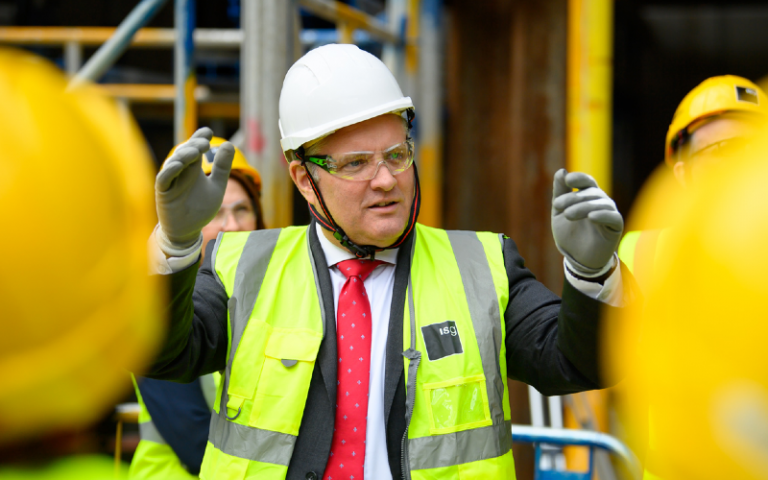We talk to Martin Treacy, Estates Project Lead, responsible for guiding and directing the team of consultants and contractors on the project

Martin Treacy, UCL Estates Lead on site at 256 Grays Inn Road at the time capsule burial (Credit Kirsten Holst)
I’m the Estates Development Project Lead and am responsible for guiding and directing the team of consultants and contractors to make sure that we're delivering the aspirations and objectives of the project and approved Business Case. In turn I report to the the various boards and Major Projects Director, Keith Butler as well as our clinical partner, UCLH.
I also work closely with the programme lead, David Howard and future users of the building to make sure that the building works for them. Also, that we’re working in accordance with the project governance and staying on track from a budgetary and compliance perspective.
I joined the project in July 2019, following the retirement of Roger Tuke who had been marshalling the team prior to then. My appointment came at a critical time whilst the planning approval process was working its way through the system at Camden culminating in the team securing full planning approval in September 2019. By the time we finish, I'll have been on the project for five years.
I work with Jessey Bonsu from the Estates Development team and am usually on site a couple of times a week or when something needs looking at in person which in a post pandemic world often reslves the issue more quickly than a virtual call.
I also work on the Institute of Education master plan refurbishment, another major project in the heart of campus, which is good for the step count as it’s a straight 15 minute walk between the two sites! The projects on the 3rd and ground floor of Queen Sq House being delivered via my colleague Petros Antoniou also come under my oversight as they are linked to the main project.
On a typical week, I meet with the contractor (ISG) and project managers Arcadis on Monday morning and go through all the current issues and or actions that need to be followed up, to keep on top of things and ensure nothing drifts. On Wednesdays, I’ll catch up again with the UCL team to pick up on other actions.
I also feed into meetings on the wider programme and monthly progress meetings to the project board, exec and steering groups. I make sure the information flow between UCL and our contractor is moving, as well as making sure people are agreeing and confirming things, so the project keeps moving and we don’t create delays.
When you’re in flight on £170 million project, early and prompt decisions and confirmations of instructions or changes are key to keeping the programme moving. A delay to the project will cost us about £150,000 a week!
While the new IoN-DRI facility is largely a new build, the refurbishment project at the IoE is more like open heart surgery as the building is fully operational with circa 3,000+ users in and out of the building on a daily basis. You can't just open the chest up and then have a cup of coffee and chat. Once you start, you're committed and have to keep going.
In between meetings, I deal with the day-to-day information flow and management issues of the project– all the issues that crop up – from a structural technical issue that needs tweaking, to amending how the ventilation is coming into the building, to keeping our finger on the pulse on how the project is impacting on our neighbours. There's an awful lot that goes on behind the scenes in between meetings.
I don't think there is a single week when something doesn't come up, it just doesn't happen in a bespoke first-time building.
Every single day presents new challenges on the project depending on what stage the projects at, so a lot of my role is problem-solving and people-orientated.
It's definitely been much easier to fix problems now covid restrictions were lifted early this year and we can have face-to-face meetings.
One of the major milestones of the project so far has been the MRI suite. The building isn’t completed until Summer 2024, but the steels need to be installed in the suite this year. Normally a specific shield is designed for a particular model of scanner, so you’d need to be deciding on the model now – two years before you move into the building.
But everyone has worked very, very hard to come up with a set of design solutions that mean we have a generic shielding design that can accommodate more than one MRI scanner model. It means the scientists are able to defer confirming the latest MRI model from the preferred supplier.
That's quite a unique situation.
 Close
Close

